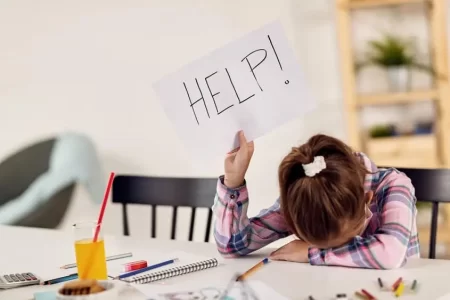Managing Attention Deficit Hyperactivity Disorder Symptoms in School
- Updated on: Jul 13, 2024
- 9 min Read
- Published on Feb 5, 2020

Attention deficit hyperactivity disorder (ADHD) is a chronic behavioral disorder characterized by symptoms like impulsiveness in behavior, hyperactivity, and inattentiveness. Mostly, this disorder is diagnosed in children but the symptoms can continue through adolescence and adulthood, therefore it may be diagnosed in adults as well. Both children and adults with ADHD can live a successful and productive life if treated and managed properly.
ADHD affects the academic, social, and family functioning of a child. Children with this disorder often experience many difficulties in their academics when compared with normal average students. Lack of attention, difficulty in sitting, and lack of controlling emotions are some of the basic symptoms in ADHD children which can make it hard for them to perform well in the school. Therefore, schools must work on managing the ADHD symptoms in children so that they can also excel in their academic career.
How Can We Manage ADHD Symptoms in School?
Children with ADHD often find it difficult to adjust in classroom settings due to which the symptoms become worse. This interferes in their academics. Schools can play an important role in managing the symptoms of ADHD children by paying a little more attention to these children compared to other normal children. To meet the needs of ADHD children, schools may offer:
- Behavioral classroom management or organizational training
- Special education services
- Accommodations (for reducing the effects of ADHD on learning)
Behavioral Classroom Management or Organizational Training
Both behavioral management and organizational training in schools can be effective for somehow managing the symptoms of ADHD in students. Behavioral management approach in the classroom focuses on ignoring the negative behavior of the child and appreciating his/her positive behavior through a reward system or a daily report card. This is a teacher-led approach and is effective in influencing the behavior of the student as well as increasing his/her academic engagement in a very constructive manner.
Behavioral management in classroom has been mostly tested in elementary schools till now but it is effective in almost children of all ages.
Organizational training in classroom mainly focuses on optimizing student learning and reducing distractions. It teaches students how to manage the time, how to organize the materials in the school, and how to develop various skills. Organizational training is effective in both children and adolescents.
Both behavioral classroom management and organizational training are two important management strategies in terms of improving the academic efficiencies of ADHD children and therefore require highly skilled and trained staff including teachers, school psychologists, and counselors. All these staff members should be experts in their fields and should follow specific teaching plans that will support the positive behavior of the child.
The American Academy of Pediatrics (AAP) recommends any ADHD treatment plan should involve a supportive and encouraging school environment, program, or placement. The American Academy of Pediatrics (AAP) has also recommended teacher-administered behavior therapy as a treatment for school-aged ADHD children.
Special Education Services
Children with ADHD should receive some services in the school like special education services and accommodations. Both these services (special education and accommodation) for disabled children are governed by two laws:
(1) The Individuals with Disabilities Education Act (IDEA)
(2) Section 504 of the Rehabilitation Act of 1973
According to these two laws, schools will provide special education services to only those ADHD children who will meet eligibility requirements for one of two federal plans funded by IDEA and Section 504: an individualized education program (IEP) or a 504 Plan.
Both these plans are different from each other. Individual educational plan (IEP) is meant for providing individualized special education services to ADHD children so that their unique special needs can be fulfilled while a 504 Plan focuses on providing services and changes to the learning environment to meet the needs of the child as adequately as other students in the normal classroom settings.
Children with ADHD are eligible for these plans only if there is evidence that the disorder will affect their ability to succeed in academics. For checking the eligibility, a team of experts observe the ADHD students and review their academic performances based on some tests.
Children with ADHD are found to be eligible for special education services under IDEA act under the following conditions:
- If the child has other health issues other than ADHD which can affect his/her alertness, vitality, or strength.
- If the child has some other specific learning disabilities (difficulty in language, reading, speaking, or writing) for example, dyslexia.
- If the child has sudden emotional disturbances in the classroom which restricts him from connecting with his peers and teachers, and therefore affects his academic performance.
- If the child has some kind of developmental delay like physical, social, or cognitive delays.
All these conditions makes a child eligible for availing special education services in the school but it should be medically documented and must correlate to having an academic impact.
Accommodations
Accommodations provided to children as per IEP and 504 plans for managing ADHD symptoms include the following:
- Allowing these children to take breaks and move around
- Giving extra time to these children during tests
- Providing positive reinforcement and feedback to such children
- Assist such children in tasks with the help of technology
- Changing the environment for avoiding distractions
- Providing extra help to these children so that they will stay organized
Although it is not completely evident that all these accommodations are effective in ADHD children but there is evidence that some accommodations like setting clear expectations, providing immediate positive feedback, and communicating daily with parents through a daily report card are helpful.
Strategies for Teachers in Managing the ADHD in the Classroom
ADHD children in classroom settings often become more impulsive and therefore present a variety of disruptive classroom behaviors (like calling out, restlessness, interrupting activities, lack of attention, etc) which puts these students at the risk of academic failure.
Different plans have been set up for meeting the special needs of ADHD children in the school. Plans like Increased Section 504 of the Vocational and Rehabilitation Act of 1973 and the Individuals with Disabilities Education Act (IDEA) of 1997 are increasing the expectations by allowing the use of classroom interventions for students with ADHD. These plans are designed to provide free and appropriate education to ADHD students. Following are some of the recommended components of these plans in the classroom settings which may be helpful for ADHD students.
General Behavior Intervention Suggestions
Some general behavior intervention principles should be followed in the classroom while dealing with the ADHD students. It should be kept in mind that these students do have a core of common problems which makes them fairly heterogeneous. Therefore, their teachers should directly target the specific problem behavior instead of focusing on ADHD symptoms.
An alternative behavior, incompatible with the problem causing behavior, should be focused and both these behaviors should be kept in mind. This will help the students not only in understanding what behavior is unacceptable but also the acceptable behavior (what we want them to do). By defining both these behaviors carefully, teachers will be able to monitor the students accurately.
Before going for any intervention plan, it is important for the teachers that they should carefully assess the behavior of the children first. Teachers should also study the antecedents and consequences of both the problem and replacement behaviors.
Antecedents may suggest some environmental changes that set up the student for success or failure while analyzing the consequences and will identify those environmental contingencies that serve to reinforce both desired and undesired behavior. The intervention plans should be based upon the function of the problem behavior.
Intervention plans should help the students in understanding that desirable behavior is a more effective way of obtaining the behavioral goal.
Environmental and Instructional Considerations
These kinds of classroom interventions followed by teachers can be very helpful for ADHD students and include the following:
Task Duration
For dealing with the student’s short attention span, the teachers should prefer that the academic assignments given to these students should be brief and the feedback regarding accuracy is immediate. If there are any longer projects, they should be broken up into manageable parts. This way the short attention span of ADHD children will not bother them in completing their tasks.
Direct Instruction
The teachers should directly instruct the ADHD students and keep them engaged which will help in improving the attention towards tasks. Also, the teaching of note-taking strategies increases the benefits of direct instruction. The development of these skills helps in improving both the comprehension and on-task behavior of students.
Peer Tutoring
Peer tutoring is very helpful for the success of ADHD students as class-wide peer tutoring provides many of the instructional variables known to be important. Along with token economy, peer tutoring has been found to yield dramatic academic gains.
Scheduling
It has been shown that the on-task behavior of students with ADHD progressively worsens over the course of the day; therefore the teachers should provide academic instructions preferably in the morning. In the afternoon, when problem-solving skills are found to be poor, teachers should schedule the activity-based non-academic activities.
Novelty
Presenting novel, interesting, and highly motivating material can be very useful in improving attention. For example, using increasing stimulation based tasks (e.g., color, shape, texture) increases the novelty and interest level of tasks, reduces activity level, improves attention and overall performance.
Structure and organization
The lessons provided to ADHD students should be carefully structured and the important points should be clearly identified because such students perform better on memory-based tasks especially when the material is meaningfully structured for them.
Auditory cues
Auditory cues to ADHD students can be useful in promoting appropriate classroom behavior. For example, the arithmetic productivity of ADHD students can be improved by using a tape with tones placed at irregular intervals to remind students to monitor their on-task behavior.
Pacing of work
Whenever possible, the students should be allowed to set their own pace for task completion as it reduces the intensity of problematic ADHD behaviors compared to situations where work is paced by others.
Instructions
The instructions given to ADHD students in the classroom should be short, specific and direct because they are unable to follow multi-step directions. Teachers should also repeat the directions frequently as these students lack attention.
Productive Physical Movement
ADHD students find it very difficult to sit still for longer durations. Therefore, teachers should plan productive physical movement for such students. For example, they should be allowed to take some stretch breaks and should be given some productive tasks like a trip to the office, a chance to sharpen a pencil, watering the plants, or simply standing at a desk while completing class work.
Difficulty in sitting is more difficult on some days and less difficult on other days. Thus, teachers need to be flexible and modify instructional demands accordingly
Active vs. Passive Involvement
Giving active tasks to ADHD students may help hyperactive students channel their disruptive behaviors into constructive responses. Where listening to long lectures in the classroom is difficult and boring for such students, involving them in the same lecture as participants (e.g., asking for help with audio-visual aids, write important points on the chalkboard, etc) is useful.
Powerful External Reinforcement
While dealing with ADHD students in the classroom, teachers should keep in mind that before eliminating the negative consequences, appropriate and rich incentives should first be developed to reinforce desired behavior. ADHD students get easily discouraged; therefore it is important to give much encouragement, praise, and affection. Also, when negative consequences are administered, they should be given in a way that students don’t feel embarrassed.
Response-Cost Programs
Some ADHD students are easy to deal within the classroom and just a few verbal reprimands are sufficient to control the negative behavior, while in other cases, the students need response-cost programs. These programs provide mild punishment to the students when problem behavior is displayed. For example, a student is given some specific number of points at the start of each day as encouragement and if the student displays problem behavior, he/she is asked to give back the points. There is evidence that such programming decreases ADHD symptoms such as impulsivity.
Some Basic Tips for Teachers to Deal With ADHD Children at School
While dealing with an ADHD child in the classroom all you need is patience, creativity, and consistency. As a teacher, you should focus on evaluating each child’s individual needs and strengths and also developing strategies that will help ADHD students to stay focused on a particular task and helping them explore their full capabilities. Successful programs developed for ADHD children should integrate the following three components:
- Accommodations: what one can do to make learning easier for students with ADHD
- Instruction: the methods one should use in teaching.
- Intervention: How one should head off behaviors that disrupt concentration or distract other students.
Besides above-mentioned components, all you need to understand about dealing with ADHD children is developing a positive attitude in yourself about this section of society. Following methods can be used in general for handling ADHD children in the classroom:
Seating Arrangements in the Classroom
Following arrangements in the classroom may help:
- Seat the child away from the doors and windows which can be sources of distraction.
- Seat the student in front of your desk if possible so that you can have a look every time.
- Ensure that the child gets disturbance-free space especially during test-taking and quiet study.
Information Delivery
While delivering information to the students, the teacher should keep the following things in mind:
- Deliver only one instruction at a time
- Repeat instructions frequently
- Give difficult tasks early in the day
- Make use of visual aids like charts, pictures, color coding, etc
Student Work
Work given to ADHD students should include the following:
- Worksheets with fewer items, small quizzes, and less number of timed sheets
- Fill in the blanks and oral tests so that such children can do best in an easier way
- Short projects rather than lengthy projects
Teaching Techniques
Following teaching techniques may be helpful for ADHD students in the classroom:
- Make use of aural cues an egg timer, a cowbell or a horn to signal the start of a lesson
- Establish an eye contact
- List all the activities to be performed on the board
- Use props, charts, and other visual aid while delivering any lesson and also keep instructions simple and structured
- Avoid asking difficult questions to ADHD students publicly as they may feel discouraged
- Include competitive games or other activities in their curriculum as ADHD students do well with these activities
- Summarize important key points
- Be specific about their homework












